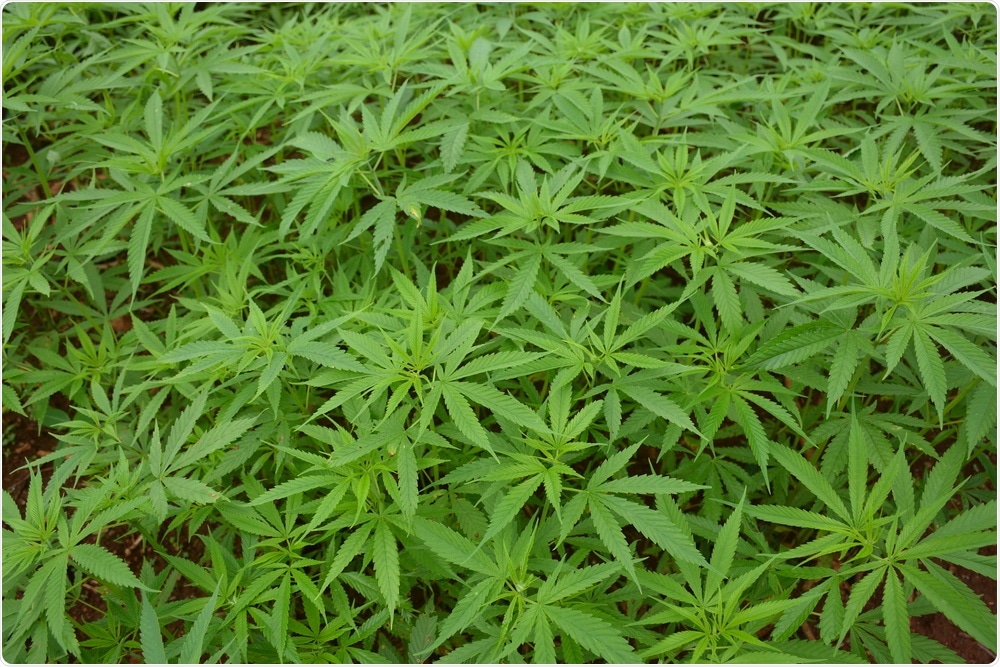A new method that can determine the sex of Cannabis sativa plants at an early stage has been established by an international team of researchers from Université Lyon and the Université de Montpellier, France, alongside those at the Russian Academy of Sciences and the All-Russia Research Institute of Agricultural Biotechnology, Russia, as well as scientists from Chongqing Medical University and BGI-Shenzhen, China.
In a paper published in the journal Genome Research this February, the team describes how it developed its new approach based on efficient RNA-seq-based segregation analysis.

Image Credit: Aran1988/Shutterstock.com
THC is only produced by female plants, early gender identification could enhance C. Sativa farming
As laws regulating the use of cannabis relax around the world, particularly in the USA, with it being legal for medical purposes in 33 states and recreational uses in 11, the production of the cannabis Sativa (C. Sativa) is rapidly increasing.
C. Sativa–derived tetrahydrocannabinol (THC) production is of particular focus of some cannabis growers. THC is the compound in cannabis that gives it its psychoactive properties, the ability to produce a ‘high’.
C. sativa is part of the group of Dioecious Plants, meaning that they can be either male or female. While both plants will produce flowers, it is only the female plant that will produce THC. Therefore, cannabis producers are sometimes only looking to grow female plants as their product is expected to contain THC.
In some cases, such as with medical marijuana growers, or those growing the plants to harvest the of another major compound found in cannabis, CBD, this focus on female plants is not important.
For those who are intending to grow cannabis with THC content, dedicating time to growing male plants is a waste of time and resources, therefore, growers are looking for ways to determine the sex of the plant early on.
In addition, there is another motivation for studying the sex chromosomes of C. sativa. Because dioecy is ancestral in the Cannabaceae family of plants, the chromosomes may be incredibly old, therefore, studying them may help to uncover key insights around plant sex chromosomes, of which, not much is currently known about.
Unfortunately, previous genome projects have failed to establish a reliable method of determining the gender of the plant at an early stage. This lack of an accurate technique for distinguishing the sex of C. sativa inspired the international team to develop such a method.
Developing a method using RNA-seq-based analysis
RNA-sequencing is used by biological sciences to identify the presence of RNA in a sample or to determine its quality. The method analyzes and provides key insights on the cellular transcriptome.
The team used RNA-sequencing to perform a segregation analysis on a C. sativa family, using SEX-DETector, a probabilistic method, to investigate all genes. The C. sativa family studied included two-parent plants along with 10 offspring plants of both male and female gender, producing 576 million reads by RNA-sequencing.
The researchers were able to determine over 500 sex-linked genes in the transcriptomes. They then mapped these onto a C. sativa genome which uncovered the largest chromosome pair as the sex chromosomes.
In C. sativa, they determined that the X-specific region was particularly large in comparison to similar plants. Also, they found that the Y chromosome in C. sativa significantly degenerates. The team’s findings led them to theorize that the C. sativa plant may hold the oldest plant sex chromosome system that has been discovered.
The team’s findings are not only insightful about the history of the evolution of plant sex chromosomes, but they also establish a method of detecting the gender of the C. sativa plant early on.
This approach will likely be beneficial to those farming the plant, to prevent them from wasting time and resources growing male plants when they are specifically wanting plants with THC content.
Source:
Legal marijuana just went on sale in Illinois. Here are all the states where cannabis is legal. Available at: https://www.businessinsider.com/legal-marijuana-states-2018-1
Journal references:
Kukurba, K. and Montgomery, S. (2015). RNA Sequencing and Analysis. Cold Spring Harbor Protocols, 2015(11), p.pdb.top084970. https://www.ncbi.nlm.nih.gov/pmc/articles/PMC4863231/
Prentout, D., Razumova, O., Rhoné, B., Badouin, H., Henri, H., Feng, C., Käfer, J., Karlov, G., and Marais, GAB. An efficient RNA-seq-based segregation analysis identifies the sex chromosomes of Cannabis sativa. Genome Res, 2020 30(2):164-172. https://www.ncbi.nlm.nih.gov/pubmed/32033943